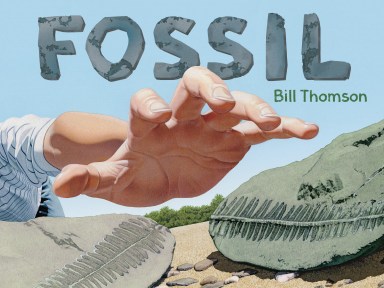We have a special book for STEM Friday today.
The word about Fossil by Bill Thomson is simply, “Wow!”
In this new wordless picture book, the intended storyline follows a boy and his dog walking on a beach. When the boy accidentally cracks open a fossil of a fern, actual ferns emerge. When they break open a fossil dragonfly, a living dragonfly skims away. The next fossil the boy opens is…
Because it is a wordless book, the reader is the one who develops the story based on the illustrations. It can change every time you read the book.
The book trailer is a great way to see how it can work:
Isn’t that amazing? By the way, Bill Thomson’s stunning illustrations are all done by hand, using acrylic paint and colored pencils.
Giveaway
Would you like to win a copy? Two Lions/Amazon is pleased to offer a giveaway copy of Fossil to one winner (U.S. addresses only). All you need to do is leave a comment on this post (with a legitimate e-mail address so we can contact you if you win) by December 6, 2013 at 11:59 P.M. PST. Entrants will be numbered in the order received and then selected at random. Note: to increase your chances of winning be sure to visit some of the other participants in the blog tour, because most are also offering giveaways. Check the blog tour links listed below for details. Edit: The giveaway has now ended and the winner has been notified. Thanks to everyone who participated.
Fossil is so stimulating, it is sure to raise questions. Here are some links for related information and activities:
1. Ferns
Ferns are a group of plants that have been found as fossils, but also can be found in forests today.
They are vascular plants, which means they have the internal channels that move water and nutrients (xylem and phloem). Ferns differ from other vascular plants because they reproduce by spores. More about ferns at Mosses, ferns, liverworts and horsetails at Growing with Science.
2. Dragonflies
These insects with large eyes and wings that stick straight out have also been found in fossils. Some of the relatives of dragonflies were larger that those found today, with wingspans over two feet wide! The adults feed on insects they catch in the air, especially pesky mosquitoes.The immature forms or nymphs live in the water.
See Dragonflies and damselflies at Growing with Science.
3. Pteranodon
One of the fun things about the book, is that kids can call the large winged reptile whatever they feel comfortable calling it. The generic name for it is pterosaur, which means “flying lizard.”
Some people have called all these flying creatures with leathery wings “pterodactyls.” Technically the genus Pterodactylus consists of only smaller pterosaurs with teeth, so you won’t catch experts calling them that.
The larger pterosaurs that lack teeth and have large crests belong to the genus Pteranodon. The creature in the book is a Pteranodon.
If you are local, it turns out there’s an exhibit of pterosaurs called Rulers of the Prehistoric Skies at the Arizona Museum of Natural History right now. Even if you aren’t local, you can download a free educator’s guide – see “Rulers of the Prehistoric Skies” under “Current Exhibit.”
Related fossil activities at Growing With Science:
Links to free guides to accompany the book at Amazon :
Fossil by Bill Thomson is sure to charge up the reader’s imagination. See where it leads your children today!
Age Range: 3 – 7 years
Publisher: Two Lions (November 5, 2013)
ISBN-10: 1477847006
ISBN-13: 978-1477847008
See a short review of Bill’s previous book, Chalk, at our sister blog, Wrapped in Foil.
Previous stops on the blog tour:
- November 9: Booking Mama (Giveaway ends November 22nd at 11:59 p.m. ET.)
- November 11: NC Teacher Stuff (Giveaway has ended)
- November 12: Just a Little Creativity (Giveaway ends Friday 11/22/13 at 11:59PM)
- November 13: There’s a Book
(Couldn’t find link) - November 14: Sharpread
(has an interview with the author) - November 15: Kid Lit Frenzy
(has interview and series of photos showing how the illustrations were done -giveaway ends Nov. 22) - November 18: Once Upon a Story (has interview- giveaway ends December 2)
- November 19: The Children’s Book Review (giveaway ends December 18 2013, at 11:59 P.M. PST)
- November 20: 5 Minutes for Books (Giveaway ends 12/3/2013 6:00 PM MST)
- November 21: Geo Librarian (With guest post by the author, giveaway ends 11/28/2013)
Disclosures: This book was provided for review purposes. Also, I am an affiliate for Amazon, and if you click through the linked titles or ads and make a purchase, I will receive a small commission at no extra charge to you. Proceeds will be used to maintain this self-hosted blog.
Come visit the STEM Friday blog each week to find more great Science, Technology, Engineering and Math books.






